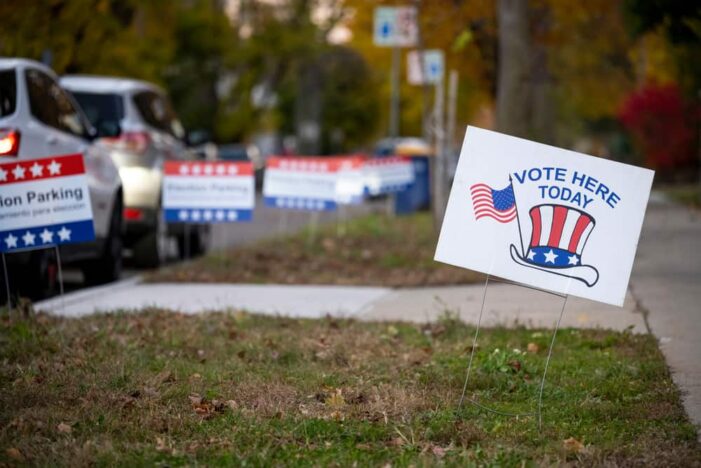Editorial credit: Ayman Haykal / Shutterstock.com
By Elena Moore | NPR
Millions of Americans can vote for the first time in the general election this fall, and while the majority of those will be voters just aging into eligibility – it’s a group that also includes new U.S. citizens spanning across generations.
An estimated 3.5 million adults of voting age have been naturalized in the U.S. since the 2020 election, according to data from the U.S. Immigration Policy Center at the University of California San Diego, with over a third from Asia, followed closely by North and Central America and nearly 11% from Africa.
New citizen voters are a group that advocates say could wield political power in the presidential race, especially in key swing states with sizable immigrant populations and where just a small portion of votes can determine a winner. That said, with lower levels of recorded turnout compared to U.S.-born voters, challenges remain in getting new citizens to show up to the polls.
“I’m not sure if this is a population that thinks of itself as, ‘we are a bloc of voters,’ in the way we oftentimes talk about Latino voters or Black voters or Asian voters,” said Mark Hugo Lopez, the director of race and ethnicity research at Pew Research Center. “But it is a notably growing group.”
In a new poll commissioned by the National Partnership for New Americans (NPNA), looking at naturalized voter attitudes, issues related to the economy rank as most important. The survey, conducted with the U.S. Immigration Policy Center, which polled individuals in Arizona, Georgia, Michigan, Nevada, Pennsylvania, Florida, California and Texas, found the issue of immigration comes immediately after economic concerns.
“New American voters care about the same things that U.S.-born voters care about,” said NPNA executive director Nicole Melaku.
A potentially influential vote
Naturalization rates in some battleground states, including Arizona, Georgia, Pennsylvania, Nevada and Wisconsin surpassed each state’s 2020 presidential vote margin. In Arizona, new citizens who became naturalized from 2016 to 2020 totaled more than six times the vote margin in the state four years ago.
“You look at the math there, and you can ascertain that if people were engaged, they would have a decisive impact in the election,” Melaku said. “You can take any part of the country, and you can see what role immigrants and naturalized voters would play in this year’s election.”
Despite naturalization data, it’s unclear how much of the population is registered to vote. The U.S. Census does not keep data on the number of newly naturalized citizens who registered to vote.
Though naturalized voters trail U.S.-born voters in overall turnout, when it’s broken down by race and ethnicity, naturalized citizens of Asian or Hispanic origin cast ballots at higher rates than individuals with those backgrounds born in the U.S., according to Pew Research Center.
Although advocates point to the potential of these immigrant voters, 2024 trends fall in line with what experts have noted in past cycles, said Lopez of Pew Research Center.
“We have generally seen the size of the eligible voter pool of naturalized citizens keep pace with [the] growth of the general eligible voter population of the United States,” he explained.
“In 2020, naturalized citizens made up 10% of eligible voters. In 2024, it’s likely to be about the same,” Lopez predicted.
The politics of new voters depends on the state
New citizens are part of different racial and economic groups around the country that hold a wide range of political beliefs.
While Asian Americans and Latinos have broadly trended Democratic, it’s changing within some communities. Lopez notably pointed to the growing conservative Latino population in south Florida, seen as a swing state less than a decade ago, now expected to go easily for former President Trump.
And party identification continues to be fairly split. In the latest NPNA survey, more than a third of naturalized voters in Florida and Michigan identify as Republican, while about 40% do in Georgia and Texas.
At the same time, over 40% of naturalized voters in Nevada, Arizona and Georgia call themselves Democrats, as well as more than a third of voters in Pennsylvania, Michigan and Florida. When including voters who lean Democrat, the number in each of these states, excluding Texas, climbs to nearly half.
Both President Biden and Trump are attempting to court voter populations that include newly naturalized citizens. In 2020, Biden won among Latino and Asian Americans, but Democrats lost ground with Hispanic voters in the midterms.
Biden’s approval also dipped with Latinos in an NPR/PBS NewsHour/Marist poll published in April.
To Nicole Melaku of NPNA, engaging these new citizen populations could have widespread political influence – but she argued politicians often fail to prioritize outreach to immigrant communities.
“I feel like new American voters… the messages aren’t resonating, or there aren’t enough engagement opportunities with the candidates,” she said.
“People just tend to lump immigrants in one category of like people that are hard to reach.”

